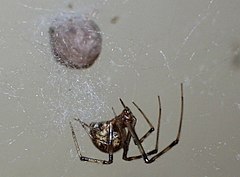Parasteatoda tepidariorum
| Common house spider | |
|---|---|
 |
|
| Common house spider and egg sac | |
| Scientific classification | |
| Kingdom: | Animalia |
| Phylum: | Arthropoda |
| Class: | Arachnida |
| Order: | Araneae |
| Family: | Theridiidae |
| Genus: | Parasteatoda |
| Species: | P. tepidariorum |
| Binomial name | |
|
Parasteatoda tepidariorum (C. L. Koch, 1841) |
|
| Synonyms | |
|
Theridion tepidariorum |
|
Theridion tepidariorum
Theridion pallidum
Theridion vulgare
Steatoda tepidariorum
Theridion marmoreum
Theridion varium
Achaearanea tepidariorum
Theridium tepidariorum
The common house spider (Parasteatoda tepidariorum), referred to internationally as the American house spider, is a spider species of the genus Parasteatoda that is mainly indigenous to the New World, with P. tepidariorum australis (common gray house spider) also encountered in some parts of Myanmar and Pakistan. American house spiders are synanthropic and build their tangled webs in or near human dwellings, often in secluded areas such as between loose walls and behind open doors and attic windows. Statistically, they are the most often encountered spider by humans in North America, and least likely to adopt defensive behavior in their vicinity. Their prey mechanism is similar to that of the other cobweb spiders: the spider follows disturbances transmitted along the web to entangle and then paralyze its prey, which usually consists of household insects and other invertebrates (often considered as pests).
American house spiders are generally dull brown in coloration, with patterns of differing shades often giving a vaguely spotted appearance (particularly noticeable on the legs). Their average body size is a quarter-inch (6 mm) long, but they can be an inch (2.5 cm) or more across with legs outspread. Their size and coloration allow the spiders to blend into the background and escape notice.
Like some other species of the family Theridiidae, P. tepidariorum is similar in body shape and size to widow spiders, which have venom that is classified as potentially dangerous.
This species can live for more than a year after reaching maturity. Each egg sac contains from 100 to more than 400 eggs, with a single female producing up to 17 egg sacs. The hatchlings remain in the mother's web for several days.
American house spiders usually feed on small insects and household pests such as flies, mosquitoes, ants and wasps. They can randomly attack grasshoppers, butterflies, cockroaches or other spiders depending on their size. If the prey is too agile, the spider will try shooting web at it from a distance before pulling the thread toward itself. Bigger females can also attract baby skinks inside their web by leaving fly remains hanging in it. Once its food dries out, the spider usually drops it to the floor in order to free space in its web, instead of destroying and rebuilding it or changing its location.
...
Wikipedia
